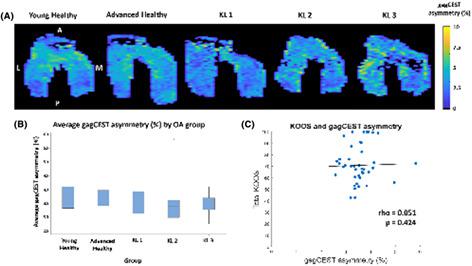当前位置:
X-MOL 学术
›
NMR Biomed.
›
论文详情
Our official English website, www.x-mol.net, welcomes your feedback! (Note: you will need to create a separate account there.)
Rapid volumetric gagCEST imaging of knee articular cartilage at 3 T: evaluation of improved dynamic range and an osteoarthritic population.
NMR in Biomedicine ( IF 2.9 ) Pub Date : 2020-05-23 , DOI: 10.1002/nbm.4310 Lauren E Watkins 1 , Elka B Rubin 2 , Valentina Mazzoli 2 , Scott D Uhlrich 3 , Arjun D Desai 4 , Marianne Black 2, 3 , Gabe K Ho 1 , Scott L Delp 1, 3, 5 , Marc E Levenston 1, 3 , Gary S Beaupré 1, 6 , Garry E Gold 1, 2, 5 , Feliks Kogan 2
NMR in Biomedicine ( IF 2.9 ) Pub Date : 2020-05-23 , DOI: 10.1002/nbm.4310 Lauren E Watkins 1 , Elka B Rubin 2 , Valentina Mazzoli 2 , Scott D Uhlrich 3 , Arjun D Desai 4 , Marianne Black 2, 3 , Gabe K Ho 1 , Scott L Delp 1, 3, 5 , Marc E Levenston 1, 3 , Gary S Beaupré 1, 6 , Garry E Gold 1, 2, 5 , Feliks Kogan 2
Affiliation

|
Chemical exchange saturation transfer of glycosaminoglycans, gagCEST, is a quantitative MR technique that has potential for assessing cartilage proteoglycan content at field strengths of 7 T and higher. However, its utility at 3 T remains unclear. The objective of this work was to implement a rapid volumetric gagCEST sequence with higher gagCEST asymmetry at 3 T to evaluate its sensitivity to osteoarthritic changes in knee articular cartilage and in comparison with T 2 and T 1ρ measures. We hypothesize that gagCEST asymmetry at 3 T decreases with increasing severity of osteoarthritis (OA). Forty‐two human volunteers, including 10 healthy subjects and 32 subjects with medial OA, were included in the study. Knee Injury and Osteoarthritis Outcome Scores (KOOS) were assessed for all subjects, and Kellgren‐Lawrence grading was performed for OA volunteers. Healthy subjects were scanned consecutively at 3 T to assess the repeatability of the volumetric gagCEST sequence at 3 T. For healthy and OA subjects, gagCEST asymmetry and T 2 and T 1ρ relaxation times were calculated for the femoral articular cartilage to assess sensitivity to OA severity. Volumetric gagCEST imaging had higher gagCEST asymmetry than single‐slice acquisitions (p = 0.015). The average scan‐rescan coefficient of variation was 6.8%. There were no significant differences in average gagCEST asymmetry between younger and older healthy controls (p = 0.655) or between healthy controls and OA subjects (p = 0.310). T 2 and T 1ρ relaxation times were elevated in OA subjects (p < 0.001 for both) compared with healthy controls and both were moderately correlated with total KOOS scores (rho = −0.181 and rho = −0.332 respectively). The gagCEST technique developed here, with volumetric scan times under 10 min and high gagCEST asymmetry at 3 T, did not vary significantly between healthy subjects and those with mild‐moderate OA. This further supports a limited utility for gagCEST imaging at 3 T for assessment of early changes in cartilage composition in OA.
中文翻译:

膝关节软骨在 3 T 下的快速体积 gagCEST 成像:对改善的动态范围和骨关节炎人群的评估。
糖胺聚糖的化学交换饱和转移 (gagCEST) 是一种定量 MR 技术,具有在 7 T 和更高场强下评估软骨蛋白聚糖含量的潜力。然而,其在 3 T 时的效用仍不清楚。这项工作的目的是实施快速体积 gagCEST 序列,在 3 T 时具有更高的 gagCEST 不对称性,以评估其对膝关节软骨骨关节炎变化的敏感性,并与T 2和T 1ρ进行比较措施。我们假设 3 T 下的 gagCEST 不对称性随着骨关节炎 (OA) 严重程度的增加而降低。该研究包括 42 名人类志愿者,包括 10 名健康受试者和 32 名患有内侧 OA 的受试者。评估所有受试者的膝关节损伤和骨关节炎结果评分 (KOOS),并对 OA 志愿者进行 Kellgren-Lawrence 分级。健康受试者在3个T连续扫描在3 T.对于健康和OA受试者,gagCEST不对称和评估体积gagCEST序列的重复性Ť 2和Ť 1ρ弛豫时间计算股骨关节软骨,以评估OA严重性灵敏度. 体积 gagCEST 成像比单切片采集具有更高的 gagCEST 不对称性(p = 0.015)。平均扫描再扫描变异系数为 6.8%。年轻和年长健康对照之间 ( p = 0.655) 或健康对照和 OA 受试者之间 ( p = 0.310) 的平均 gagCEST 不对称性没有显着差异。OA 受试者的T 2和T 1ρ弛豫时间升高(p< 0.001) 与健康对照相比,两者均与总 KOOS 得分中度相关(分别为 rho = -0.181 和 rho = -0.332)。此处开发的 gagCEST 技术具有 10 分钟以下的体积扫描时间和 3 T 时的高 gagCEST 不对称性,在健康受试者和轻中度 OA 受试者之间没有显着差异。这进一步支持了 3 T gagCEST 成像用于评估 OA 中软骨成分的早期变化的有限效用。
更新日期:2020-07-08
中文翻译:

膝关节软骨在 3 T 下的快速体积 gagCEST 成像:对改善的动态范围和骨关节炎人群的评估。
糖胺聚糖的化学交换饱和转移 (gagCEST) 是一种定量 MR 技术,具有在 7 T 和更高场强下评估软骨蛋白聚糖含量的潜力。然而,其在 3 T 时的效用仍不清楚。这项工作的目的是实施快速体积 gagCEST 序列,在 3 T 时具有更高的 gagCEST 不对称性,以评估其对膝关节软骨骨关节炎变化的敏感性,并与T 2和T 1ρ进行比较措施。我们假设 3 T 下的 gagCEST 不对称性随着骨关节炎 (OA) 严重程度的增加而降低。该研究包括 42 名人类志愿者,包括 10 名健康受试者和 32 名患有内侧 OA 的受试者。评估所有受试者的膝关节损伤和骨关节炎结果评分 (KOOS),并对 OA 志愿者进行 Kellgren-Lawrence 分级。健康受试者在3个T连续扫描在3 T.对于健康和OA受试者,gagCEST不对称和评估体积gagCEST序列的重复性Ť 2和Ť 1ρ弛豫时间计算股骨关节软骨,以评估OA严重性灵敏度. 体积 gagCEST 成像比单切片采集具有更高的 gagCEST 不对称性(p = 0.015)。平均扫描再扫描变异系数为 6.8%。年轻和年长健康对照之间 ( p = 0.655) 或健康对照和 OA 受试者之间 ( p = 0.310) 的平均 gagCEST 不对称性没有显着差异。OA 受试者的T 2和T 1ρ弛豫时间升高(p< 0.001) 与健康对照相比,两者均与总 KOOS 得分中度相关(分别为 rho = -0.181 和 rho = -0.332)。此处开发的 gagCEST 技术具有 10 分钟以下的体积扫描时间和 3 T 时的高 gagCEST 不对称性,在健康受试者和轻中度 OA 受试者之间没有显着差异。这进一步支持了 3 T gagCEST 成像用于评估 OA 中软骨成分的早期变化的有限效用。


























 京公网安备 11010802027423号
京公网安备 11010802027423号